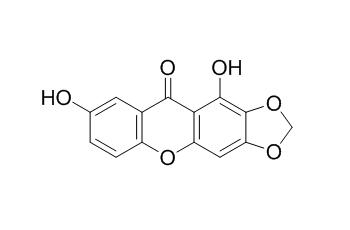1,7-Dihydroxy-2,3-methylenedioxyxanthone
1,7-Dihydroxy-2,3-methylenedioxyxanthone has antiulcerogenic, anti-oxidation, and antihyperalgesic activities, it can inhibit the carrageenan-induced hyperalgesia.
Inquire / Order:
manager@chemfaces.com
Technical Inquiries:
service@chemfaces.com
Tel:
+86-27-84237783
Fax:
+86-27-84254680
Address:
1 Building, No. 83, CheCheng Rd., Wuhan Economic and Technological Development Zone, Wuhan, Hubei 430056, PRC
Providing storage is as stated on the product vial and the vial is kept tightly sealed, the product can be stored for up to
24 months(2-8C).
Wherever possible, you should prepare and use solutions on the same day. However, if you need to make up stock solutions in advance, we recommend that you store the solution as aliquots in tightly sealed vials at -20C. Generally, these will be useable for up to two weeks. Before use, and prior to opening the vial we recommend that you allow your product to equilibrate to room temperature for at least 1 hour.
Need more advice on solubility, usage and handling? Please email to: service@chemfaces.com
The packaging of the product may have turned upside down during transportation, resulting in the natural compounds adhering to the neck or cap of the vial. take the vial out of its packaging and gently shake to let the compounds fall to the bottom of the vial. for liquid products, centrifuge at 200-500 RPM to gather the liquid at the bottom of the vial. try to avoid loss or contamination during handling.
Int J Mol Sci.2023, 24(8):7442.
Environ Toxicol.2021, 36(9):1848-1856.
J Ethnopharmacol.2017, 206:73-77
Nutrients.2023, 15(24):5020.
Sci Rep.2023, 13(1):14594.
Antioxidants (Basel).2022, 11(12):2496.
Asian Journal of Chemistry2014, 26(22):7811-7816
Molecules.2022, 27(21):7514.
Int Immunopharmacol.2023, 123:110572.
Pharmaceutics.2022, 14(3):564.
Related and Featured Products
Zhongguo Zhong Yao Za Zhi. 2005 Jun;30(11):827-30.
Chemical constituents in roots of Polygala fallax and their anti-oxidation activities in vitro.[Pubmed:
16110862]
To study the chemical constituents in roots of P. fallax and their anti-oxidation activities in vitro.
METHODS AND RESULTS:
Column chromatographic techniques were employed for isolation and purification of chemical constituents of the plant. The structures were elucidated on the basis of the spectral evidence and the physical and chemical character. The isolated compounds were screened with four anti-oxidation models in vitro. Seven xanthones, 1,7-Dihydroxy-2,3-methylenedioxyxanthone (1), 1-methoxy-2,3-methylenedioxyxanthone (2), 3-hydroxy-1,2-dimethoxyxanthone (3), 1,6,7-trihydroxy-2,3-dimethoxyxanthone (4), 7-hydroxy-1-methoxy-2,3-methylenedioxyxanthone (5), 1,3-dihydroxy-2-methoxyxanthone (6) and 1,3,7-trihydroxy-2-methoxyxanthone (7), were isolated from the roots of P. fallax. And compounds 1 - 7 showed different anti-oxidation activities in the different pharmacological models.
CONCLUSIONS:
Compounds 2, 3, 5 and 7 were isolated from this plant for the first time. Xanthones from this plant showed anti-oxidation activities. The pharmacological activities of the pure compounds from this plant were also reported for the first time.
Basic Clin Pharmacol Toxicol. 2012 Sep;111(3):145-53.
Antihyperalgesic activity of the methanol extract and some constituents obtained from Polygala cyparissias (Polygalaceae).[Pubmed:
22381005]
Polygala cyparissias, used in folk medicine as an anaesthetic, has already demonstrated antinociceptive activity against acute pain.
METHODS AND RESULTS:
In this study, we investigated the antihyperalgesic activity of the P. cyparissias methanol extract (PCME) from which the following compounds were isolated: α-spinasterol (PC1), 1,3-dihydroxy-7-methoxyxanthone (PC2), 1,7-Dihydroxy-2,3-methylenedioxyxanthone (PC3) and 1,3,6,8-tetrahydroxy-2,7-dimethoxyxanthone (PC4). The antihyperalgesic effect was evaluated using experimental models of persistent pain induced by carrageenan, lipopolysaccharide (LPS), Freund's Complete Adjuvant (CFA), PGE(2) or epinephrine. The partial ligation of the sciatic nerve (PLSN) model was also used. In inflammatory hyperalgesia induced by carrageenan, LPS, CFA or PGE(2), the inhibition values obtained with the PCME treatment were 68 ± 3%, 89 ± 5%, 43 ± 3% and 40 ± 4%, respectively. In epinephrine-induced hyperalgesia, the extract was effective, reducing 99 ± 11% of response frequency, while in PLSN, 54 ± 4% of inhibition was obtained. These results allow to suggest that the antihyperalgesic activity of PCME is, at least in part, related to its capability to inhibit the hypersensitization induced by pro-inflammatory mediators, such as LPS, carrageenan and CFA, without interfering with locomotor activity or motor performance. Furthermore, compounds PC1, PC3 and PC4 inhibited the carrageenan-induced hyperalgesia with inhibition of 42 ± 6%, 48 ± 5% and 64 ± 4%, respectively.
CONCLUSIONS:
In summary, our data demonstrate that PCME has relevant antihyperalgesic activity and that the isolated PC1, PC3 and PC4 seem to be responsible, at least in part, for this important effect.
Naunyn Schmiedebergs Arch Pharmacol. 2010 Feb;381(2):121-6.
Antiulcerogenic activity of extract, fractions, and some compounds obtained from Polygala cyparissias St. Hillaire & Moquin (Polygalaceae).[Pubmed:
20054524]
The present study evaluates the gastroprotective properties of acetone extract, chloroform, and methanol fractions, alpha-spinasterol (1); 1,3-dihydroxy-7-methoxyxanthone (2); and 1,7-Dihydroxy-2,3-methylenedioxyxanthone (3) obtained from Polygala cyparissias (Polygalaceae).
METHODS AND RESULTS:
Gastroprotective assays were performed in mice using ethanol/HCl and nonsteroidal anti-inflammatory drug (NSAID)/bethanechol-induced ulcer models. Chloroformic fraction showed no interesting results. On the other hand, in the ethanol/HCl-induced ulcer model, the treatment using doses of 50, 125, and 250 mg/kg promoted ulcer inhibition of 45.19+/-12.93%, 62.99+/-3.49%, and 67.40+/-4.75% for acetone extract and 43.70+/-5.12%, 64.56+/-5.64%, and 74.49+/-6.13% for methanol fraction. In the model of NSAID/bethanechol-induced ulcer, the ulcer inhibitions in the same doses were 28.12+/-12.45%, 60.16+/-6.58%, and 77.86+/-7.18% for the acetone extract and 46.09+/-6.92%, 67.45+/-4.36%, and 75.00+/-2.92% for the methanol fraction. In view of the antiulcer potential of the acetone extract and its high yield and xanthone content, it was submitted to chromatographic procedures, giving compounds 1-3, which were also evaluated in the ethanol-induced ulcer model.
CONCLUSIONS:
The results showed that at a dose of 50 mg/kg, these compounds reduced the percentage of ulcer by around 71.26+/-9.40%, 81.10+/-5.75%, and 86.22+/-3.42%, for compounds 1, 2, and 3, respectively. The antiulcerogenic activity of P. cyparissias may be attributed, at least in part, to these compounds.



